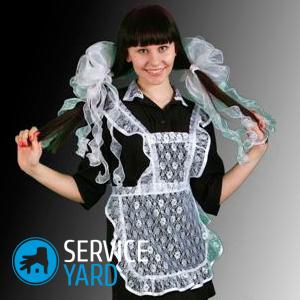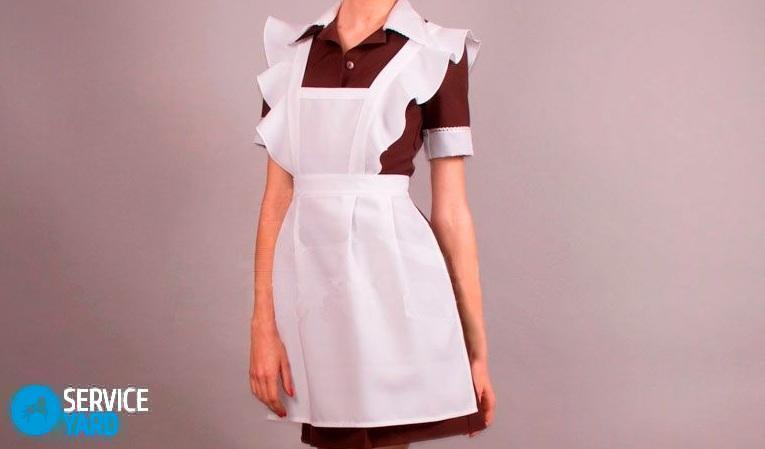How to sew a school apron?

Fashion has long appeared when graduates come to the last bell, dressed in elegant school dresses with lush bows and snow-white aprons. These dresses are often stored in grandmother’s chests of drawers, and only go out once a year. Unfortunately, the aprons for them are not so well preserved, and in order to find a suitable copy, you have to put a lot of effort. Therefore, an excellent solution would be its independent manufacture. Let's see how to sew a school apron.
to contents ↑Varieties of simple and elegant patterns
You can make a school apron from various fabrics, for example:
- Guipure is the most popular material, which is characterized by lightness, affordable cost and attractive appearance.
- Lace fabric - the fabric is a bit like not guipure, but with a denser structure.
- Batiste is a simple, easy to cut and maintain material, without any frills. It has an affordable price.
- Atlas is a modern variation of the cambric. Outwardly, it resembles silk, but it is quite difficult to sew, so it is better to entrust the seamstress to work with this fabric.
- Nylon is a synthetic fabric that is rarely used for sewing a school apron with your own hands.
Features of the cut
The most common models of school aprons consist of a lower part, a bib, a belt, two straps and frills.
Important! It looks very interesting models where there is a bib, and wide straps go from the belt, with minimal frills. Such a design idea lengthens the neck and stretches a low silhouette - so, the figure of the girl will look slimmer.
Also, consider such tips when choosing a style:
- Chubby girls should not choose rectangular models of aprons, as they can visually expand the waist and reduce growth even more.
- The bottom has a rounded shape, less often rectangular, the length is equal to the dress or a little shorter, tucks and tucks are made in the region of the belt.
- Folds and ruffles are made on the bottom, which must be carefully ironed.
- The lower and lateral edges are sewn up, bending the fabric, or a narrow braid is sewn to them.
- The belt is narrow, mainly tied to the back of the bow.
- The chest part can be of different shapes, it should be chosen according to the taste of the girl herself - trapezoidal, rectangular, with folds on the belt, rounded.
Sewing a school apron with your own hands
To sew a school apron, you need the following:
- The cut of the main fabric is an average of 1 meter, with a width of 1.5 meters (the amount of fabric is determined after the construction of the pattern).
- White interlining for light tissues.
- White sewing threads and needles.
- Tape measure.
- Chalk for marking.
- Material for decoration (in our case, lace from lace).
Building patterns
The school apron consists of several main parts - the upper and lower panels, straps, belt and frills. In some models it can be without a bib, with a rather deep V-neck - in this case, elongated straps are sewn in front, directly to the belt.
Important! It is advisable to take measurements with a school dress on.
Operating procedure:
- The front panel is a rectangle of fabric. In this case, the length is equal to half the circumference of the waist, plus about 5-10 cm on both sides for dressing. The optimum height is approximately 5 cm shorter than the dress with which the apron will be worn. If desired, the lower corners of the panel can be rounded.
- The bib is trapezoidal, where the height is the distance from the chest line to the waist, the top is 20-25 cm, and the width of the bottom is 12-20 cm.
- The length of the straps is determined as follows: attach the edge of the measuring tape in front, to the line of the belt, pull it over the shoulder and back to the line of the belt at the back. Then add seam allowances to the measured length. The width of the straps is about 3-5 cm.
- Ruffles are cut in the form of rectangles with rounded corners. The recommended width of the frill is about 5-6 cm. The length of the frill should be equal to the length of the strap multiplied by 1.5 - here, the larger the coefficient, the more magnificent the frill will be.
- The width of the belt should be equal to the coverage of the waist with an allowance for tying or fastening.
Important! All parts must be left with allowance for hemming and stitching. If you plan to process the edges using edging, then stocks on the lower canvas are not needed.
Sewing
Sewing a school apron with your own hands is as follows:
- Work the edges of the bottom and do the sewing.
- On the bib, process only the upper part.
- Gather frills, sew them to the straps.
- Sew a bib between the straps.
- Sew a bib with straps between the elements of the belt, smooth the seam allowances on the belt, grasp the front panel to the lower part of the belt, cover with the upper part, gently tack the belt along the entire length with seam allowances tucked in and then sew along the entire perimeter.
to contents ↑Important! Straps, to the back of the belt can be attached with the usual buttons that are sewn to it from the inside. It will be imperceptible, and the apron will be put on much faster.
Stock footage
The last call is an exciting event for every graduate. A beautiful dress, snow-white bows and, of course, a smart school apron - all this should be perfect. To look one hundred percent, you can sew a school apron on your own - so you get a beautiful thing that will only be with you and no one else.
- How to choose a vacuum cleaner taking into account the characteristics of the house and coatings?
- What to look for when choosing a water delivery
- How to quickly create comfort at home - tips for housewives
- How to choose the perfect TV - useful tips
- What to look for when choosing blinds
- What should be running shoes?
- What useful things can you buy in a hardware store
- Iphone 11 pro max review
- Than iPhone is better than Android smartphones




